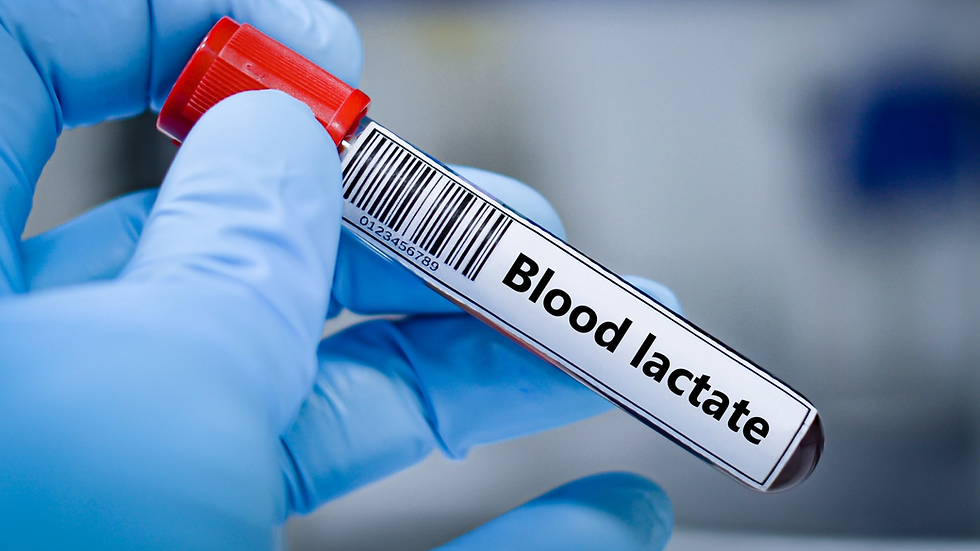LACTATE THRESHOLD TEST
- Moran Sciamama-Saghiv
- Sep 3
- 5 min read
The lactate threshold test is essential for athletes and fitness enthusiasts aiming to boost their performance. Discovering your lactate threshold reveals important insights about your endurance capabilities and allows you to better tailor your training regimen. In this post, you will learn about the lactate threshold, its significance, preparation steps, and how to effectively interpret your results.
What is Lactate Threshold?
Lactate threshold is the exercise intensity where lactate starts to build up in the bloodstream. During low-intensity exercise, your body can remove lactate quickly as it is produced. However, as you exert yourself more, there’s a tipping point where lactate production outpaces its clearance, raising blood lactate levels. This threshold reflects your aerobic endurance and overall fitness level.
Knowing your lactate threshold is invaluable in determining the best training zones to enhance your performance. Training around this threshold increases your body’s ability to use oxygen and helps delay fatigue.
Why is the Lactate Threshold Test Important?
The lactate threshold test holds several benefits for athletes and fitness enthusiasts:
Performance Optimization: By understanding your lactate threshold, you can tailor your training to enhance endurance. For instance, a marathon runner may adjust their pacing strategy based on their threshold results.
Training Zones: The test helps pinpoint your training zones, allowing for more effective workouts. Research shows that athletes training in the correct zones can improve their performance by up to 15%.
Progress Tracking: Regular lactate threshold testing lets you monitor your progress. A study by the American College of Sports Medicine found that athletes who tracked their threshold saw significant improvements over six months.
Injury Prevention: Knowing your limits helps avoid overtraining and minimizes injury risks. For example, understanding your lactate threshold may prevent a cyclist from pushing too hard in a race setting.
Personalized Training Plans: Your results can shape tailored training plans, catering to your unique physiological responses.
Preparing for the Lactate Threshold Test
Proper preparation is vital for accurate results in your lactate threshold test. Follow these steps:
1. Choose the Right Environment
Conduct your test in a controlled setting, such as a lab or equipped gym. Ensure that equipment is calibrated, and have access to machines like a treadmill or stationary bike.
2. Hydration and Nutrition
Stay well-hydrated leading up to the test. On test day, eat a light meal rich in carbohydrates while low in fat and protein; for example, a slice of whole-grain toast and a banana. Avoid heavy meals that can upset your stomach.
3. Rest and Recovery
Be well-rested before the test. Refrain from strenuous workouts in the days prior, as fatigue can affect performance and results accuracy.
4. Warm-Up
A thorough warm-up is crucial. Spend 10-15 minutes engaging in light aerobic activity to gradually raise your heart rate and increase blood flow to your muscles.
Conducting the Lactate Threshold Test
The test typically involves a graded exercise protocol, progressively increasing exercise intensity. Here’s a general outline:
1. Baseline Measurement
Before starting, measure your resting heart rate and blood lactate levels. This sets a reference point for your results.
2. Incremental Exercise
You will engage in exercise at gradually increasing intensities, with typical intervals lasting 3-5 minutes. Blood samples are taken at each stage to measure lactate levels, usually via a quick finger prick.
3. Monitoring Heart Rate
Your heart rate will be monitored throughout the test, providing crucial data to help define your lactate threshold.
4. Cool Down
After reaching maximum effort, cool down gradually to allow your heart rate to stabilize.
Interpreting the Results
Upon completing the test, the collected data will clarify your lactate threshold. Here's how to interpret those findings:
1. Lactate Levels
Focus on lactate levels measured at different intensities. A notable increase in lactate indicates you've surpassed your lactate threshold.
2. Heart Rate
Your heart rate at the lactate accumulation point is also significant. This supports establishing your effective training zones.
3. Training Zones
From your lactate threshold, identify your training zones:
Zone 1: Recovery (below lactate threshold)
Zone 2: Aerobic (at or just below lactate threshold)
Zone 3: Anaerobic (above lactate threshold)
4. Adjusting Training
Use these insights to modify your training plan. Focus on workouts that improve your lactate threshold, enhancing your endurance and performance over time.

Common Misconceptions About Lactate Threshold
Several misunderstandings about lactate threshold can lead to confusion. Here are clarifications:
1. Lactate is Not a Waste Product
Many view lactate as a mere byproduct of exercise. However, it serves as an important energy source that the body can use during prolonged activity.
2. Lactate Threshold is Not Fixed
Your lactate threshold can evolve with training. Regular testing helps track these changes and allows you to adjust your training plan.
3. It’s Not Just for Elite Athletes
While elite athletes often utilize lactate threshold testing, it benefits anyone aiming to enhance their fitness, from casual runners to competitive cyclists. Understanding your lactate threshold can significantly improve your training outcomes.
Incorporating Lactate Threshold Training into Your Routine
After identifying your lactate threshold, you can use specific training strategies to enhance it. Consider the following effective methods:
1. Tempo Runs
Tempo runs involve maintaining a steady pace just below your lactate threshold. This training improves your ability to clear lactate, boosting endurance over time. For example, a runner could perform a tempo run at a pace they can hold for one hour, which is typically just below their threshold.
2. Interval Training
Incorporate high-intensity interval training (HIIT) into your regimen. Short bursts of intense exercise with recovery periods can elevate your lactate threshold. For instance, alternate sprints of 30 seconds with two minutes of walking or easy jogging.
3. Long, Slow Distance (LSD) Training
Long, slow-distance training builds your aerobic capacity. Over time, this helps your body adapt to extended exercise while improving lactate clearance.
4. Cross-Training
Integrate different forms of exercise, such as cycling, swimming, or rowing. These diversify your workouts and enhance your overall fitness, positively affecting your lactate threshold.
Monitoring Progress
To ensure your training is effective, monitoring your progress regularly is crucial. Here are some tips:
1. Repeat Testing
Consider retesting your lactate threshold every three to six months to evaluate changes and adapt your training plan appropriately.
2. Keep a Training Log
Maintain a training log documenting your workouts, including intensity, duration, and how you felt. This log will help you recognize patterns and make informed adjustments.
3. Listen to Your Body
Pay attention to your body. If you notice fatigue or declining performance, it may signal the need to reassess your training.

Optimizing Your Performance
The lactate threshold test is a valuable tool for anyone looking to improve performance. Understanding your lactate threshold lets you tailor your training for better endurance and tracking of your progress over time.
Incorporating lactate threshold training into your routine can yield dramatic fitness improvements. Ensure you prepare adequately for the test, interpret results thoughtfully, and adjust your training as needed. With persistence and the right strategies, you can elevate your performance and reach your fitness aspirations.

Services by Dr. Moran Sciamama-Saghiv:





Comments